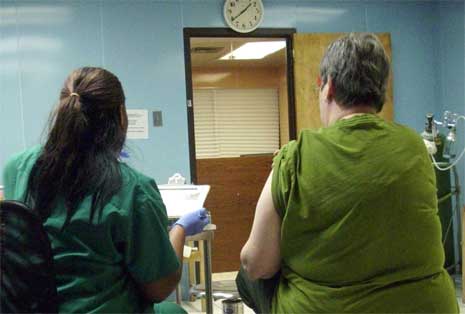Breakthrough study on Multiple Chemical Sensitivity shows MCS is an epidemic caused by toxic chemicals; peer-reviewed paper is published in prestigious toxicology reference work.
 A major paper on multiple chemical sensitivity by Professor Martin L. Pall is to be published October 23, 2009 as chapter XX in a prestigious reference work for professional toxicologists, “General and Applied Toxicology, 3rd Edition” (John Wiley & Sons). Multiple chemical sensitivity (MCS) is also known as chemical sensitivity, chemical intolerance and toxicant-induced loss of tolerance, with this last name emphasizing the role of chemicals in initiating cases of this disease. Pall’s paper, entitled Multiple Chemical Sensitivity: Toxicological Questions and Mechanisms, establishes five important facts about MCS:
A major paper on multiple chemical sensitivity by Professor Martin L. Pall is to be published October 23, 2009 as chapter XX in a prestigious reference work for professional toxicologists, “General and Applied Toxicology, 3rd Edition” (John Wiley & Sons). Multiple chemical sensitivity (MCS) is also known as chemical sensitivity, chemical intolerance and toxicant-induced loss of tolerance, with this last name emphasizing the role of chemicals in initiating cases of this disease. Pall’s paper, entitled Multiple Chemical Sensitivity: Toxicological Questions and Mechanisms, establishes five important facts about MCS:
1. MCS is a stunningly common disease, even more common than diabetes. This has been shown in a series of nine epidemiological studies from the U.S. and one study each from Canada, Germany, Sweden and Denmark. In the U.S., approximately 3.5% of the population is affected by severe MCS, with much larger numbers, at least 12% of the population, being moderately affected. MCS is, therefore, a very large international disease epidemic with major implications in terms of public health.
2. MCS is caused by toxic chemical exposure. Cases of MCS are initiated by exposure to seven classes of chemicals. These include three classes of pesticides and the very large class of organic solvents and related compounds. In addition, published studies implicate mercury, hydrogen sulfide and carbon monoxide as initiators. All seven of these classes of chemicals have been shown in animal studies to produce a common response in the body, excessive activity of a receptor in the body known as the NMDA receptor. Furthermore animal studies have demonstrated that chemicals belonging to each of these seven classes can have their toxic responses greatly lowered by using drugs that lower this NMDA response. Because excessive NMDA activity is implicated in MCS from other studies, we now have a compelling common response that explains how such diverse chemicals can produce the disease that we call MCS.
3. The role of chemicals acting as toxicants in MCS has been confirmed by genetic studies. Four such studies have shown that genes that determine the rate of metabolism of chemicals otherwise implicated in MCS, influence susceptibility to becoming ill with MCS. These four studies have been published by three research groups in three countries, the U.S., Canada and Germany, have collectively implicated six genes in determining susceptibility to MCS. Each of these six genes has a role in determining the rate of metabolism of MCS-related chemicals. The German studies by Schnakenberg and colleagues are particularly convincing on this because of the extremely high level of statistical significance of their studies implicating four of these six genes. There is only one interpretation for the role of these six genes in determining susceptibility to MCS. It is that chemicals act as toxicants in initiating cases of MCS and that metabolizing these chemicals into forms that are either less or more active in such initiation, influences therefore, the probability that a person will become ill with MCS. It is clear, therefore, that MCS is a toxicological phenomenon, with cases being caused by the toxic response to chemical exposure.
4. We have, a detailed and generally well supported mechanism for MCS. This mechanism explains both the high level chemical sensitivity that is the most characteristic symptom of MCS, as well as many other symptoms and signs of this disease, can be generated. This mechanism is centered on a biochemical vicious cycle, known as the NO/ONOO- cycle, which interacts with other mechanisms previously implicated in MCS, notably neural sensitization and neurogenic inflammation. These act locally, in various tissues of the body, to generate local sensitivity in regions of the brain and in peripheral tissues including lungs, upper respiratory tract and regions of the skin and the GI tract. Because of this local nature, different MCS patients differ from one another in their sensitivity symptoms, because the tissues impacted differ from one patient to another. In addition to the evidence discussed above, this general mechanism is supported by various physiological changes found in MCS and in related illnesses, by studies of MCS animal models, by objectively measurable responses of MCS patients to low level chemical exposure and by therapeutic responses reported for MCS and related illnesses.
5. For over 20 years, some have falsely argued that MCS is a psychogenic disease, being generated in their view by some ill defined psychological mechanism. However this view is completely incompatible with all of the evidence discussed earlier in this release. While such incompatibility is more than sufficient reason to reject these psychogenic claims, the MCS toxicology paper lists eight additional serious flaws in the psychogenic arguments. There is a long history of false psychogenic claims in medicine, where such diseases as asthma, autism, Parkinson’s disease, ulcers, multiple sclerosis, lupus, interstitial cystitis, migraine and ulcerative colitis have been claimed to be generated by a psychological mechanism. The 2005 Nobel Prize in physiology and medicine was give to Drs. Robin Warren and Barry Marshall for showing that ulcers are caused by a bacterial infection, and are not of psychogenic origin. It is clear, now, that MCS is physiological disease initiated by toxic chemical exposure that has been falsely claimed to be psychogenic.
—
Martin L. Pall is Professor Emeritus of Biochemistry and Basic Medical Science, at Washington State University.
He is located on Pacific time in the U.S. and can be contacted at: 503-232-3883 and at martin_pall@wsu.edu.
His Website is: www.thetenthparadigm.org
Related Articles:
 Among dietary factors, learning and behavior are influenced not only by nutrients, but also by exposure to toxic food contaminants such as mercury that can disrupt metabolic processes and alter neuronal plasticity.
Among dietary factors, learning and behavior are influenced not only by nutrients, but also by exposure to toxic food contaminants such as mercury that can disrupt metabolic processes and alter neuronal plasticity. 



 A major paper on multiple chemical sensitivity by Professor Martin L. Pall is to be published October 23, 2009 as chapter XX in a prestigious reference work for professional toxicologists, “General and Applied Toxicology, 3rd Edition” (John Wiley & Sons). Multiple chemical sensitivity (MCS) is also known as chemical sensitivity, chemical intolerance and toxicant-induced loss of tolerance, with this last name emphasizing the role of chemicals in initiating cases of this disease. Pall’s paper, entitled Multiple Chemical Sensitivity: Toxicological Questions and Mechanisms, establishes five important facts about MCS:
A major paper on multiple chemical sensitivity by Professor Martin L. Pall is to be published October 23, 2009 as chapter XX in a prestigious reference work for professional toxicologists, “General and Applied Toxicology, 3rd Edition” (John Wiley & Sons). Multiple chemical sensitivity (MCS) is also known as chemical sensitivity, chemical intolerance and toxicant-induced loss of tolerance, with this last name emphasizing the role of chemicals in initiating cases of this disease. Pall’s paper, entitled Multiple Chemical Sensitivity: Toxicological Questions and Mechanisms, establishes five important facts about MCS: